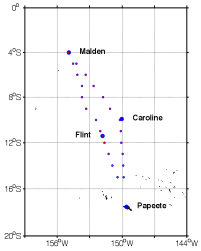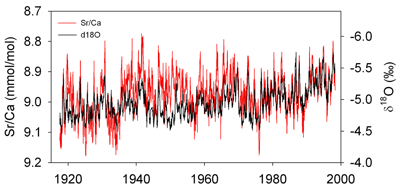
Back to Table of Contents
46207-AC2
Coral records of late 20th century tropical Pacific upwelling: investigating a potential climate-carbon feedback
Kim Cobb, Georgia Institute of Technology
Year 2 Progress Report: "Coral records of late
20th century tropical Pacific upwelling: investigating a potential climate-carbon feedback"
PI: Kim CobbDate: 4/26/09
The
proposal aims to deliver quantitative estimates of temperature, hydrology, and upwelling
changes over the last 50 years by applying multiple geochemical proxies to a
suite of coral cores from the central tropical Pacific. The geochemical proxies
that have been analyzed on these cores to date include: oxygen isotopes (d18O) as a proxy for temperature and
hydrology, Sr/Ca ratios as a proxy of coral
temperature, and Cd and Ba/Ca
ratios as potential upwelling proxies. Graduate student Intan
Suci-Nurhati has performed all the analyses for this
project, under PI Cobb's supervision, and in collaboration with Dr. Bill
McDonough (U. Maryland), Dr. Chris Charles (SIO-UCSD), and Dr. Rob Dunbar
(Stanford).
 |
Figure 1. Map of cruise track for Southern Line Islands Expedition in October, 2008. |
The Georgia Tech Southern Line Islands
coral cruise, October 2008
The
primary objectives of the cruise (partially funded by PRF funding) was to
survey corals in the southern Line Islands group (Caroline, Malden and Flint
Islands; see Figure 1) and retrieve living coral cores to reconstruct 20th
century tropical Pacific climate. Samples collected from the cruise complement
our ongoing PRF-funded work from the northern Line Islands group (Palmyra,
Fanning and Christmas Islands) in investigating the role of the tropical
Pacific climate in the current greenhouse forcing (Nurhati
et al., submitted). Along the cruise track (Figure 1), we conducted seawater
sampling every 1û latitude and continuous underway sea-surface temperature logging.
Long temperature and hydrology records
from northern Line Island corals: Sr/Ca and d18Osw
Our
previous work (Nurhati et al., submitted)
demonstrates the power of combining the two most robust coral climate proxies,
namely Sr/Ca ratios and oxygen isotopic values (d18O), to reconstruct the temperature and
hydrological history of the central tropical Pacific over the last thirty
years. Our approach emphasizes regional reproducibility (by constructing coral
geochemical records from three neighboring islands) and site reproducibility
(by constructing multiple coral geochemical records from the same site). Our
results indicate that the tropical Pacific has undergone a shift towards "El
Nino-like" conditions over the last decades – a trend that we believe is
related to anthropogenic greenhouse forcing and thus will continue in coming
decades. Ongoing
work with corals from the same northern Line Islands sites that were used in Nurhti et al. (submitted) focus on extending the coral
climate proxy records to the early 20th century. This research will
allow us to better interpret the climatic signals uncovered in the short, 30yr
records already completed – allowing for the clear identification of any
anthropogenic-related signals (which presumably could be detected by comparing
the early and late 20th century portions of the coral geochemical timeseries). Preliminary data from Palmyra Island (6N,
162W) is shown in Figure 2. By comparing the coral d18O and Sr/Ca
records over the 20th century, we can gain insights into the history
of warming (Sr/Ca) versus freshening (d18O-Sr/Ca) over this time period. The Sr/Ca record indicates that late 20th century
warming is not unprecedented in the Palmyra coral record (a result that will be
tested with additional coral Sr/Ca records from
southern neighbors Fanning and Christmas Islands) (Figure 2). However, the d18O record indicates that late 20th
century freshening is unprecedented, and likely reflects a shift in the
Inter-tropical Convergence Zone that has occurred since ~1970AD.
 |
Figure 2. Long records of coral d18O (temperature and precipitation) and Sr/Ca (temperaure only) from Palmyra Island (6N, 162W). The Palmyra record will extend to 1886AD, while other Northern Line Island coral cores from Fanning (4N, 160W) and Christmas (2N, 157W) extend to 1923AD and 1938AD, respectively. We will complete these additional long d18O and Sr/Ca records in the next year. |
In summary, our coral geochemical work has yielded new
insights into the recent history of tropical Pacific climate, far beyond the
reach of sparse instrumental records in this remote region. Our tasks for the
next year (a 1 year no-cost extension has been requested) include completing
the long coral timeseries from the northern Line
Islands, and investigating the new coral climate records from the southern Line
Islands.
References:Nurhati, I.S.*, Cobb, K.M., Charles, C.D.,
Dunbar, R.B. Late 20th century trend warming and freshening in the
central tropical Pacific, Submitted to Geophysical
Research Letters.
Back to top



